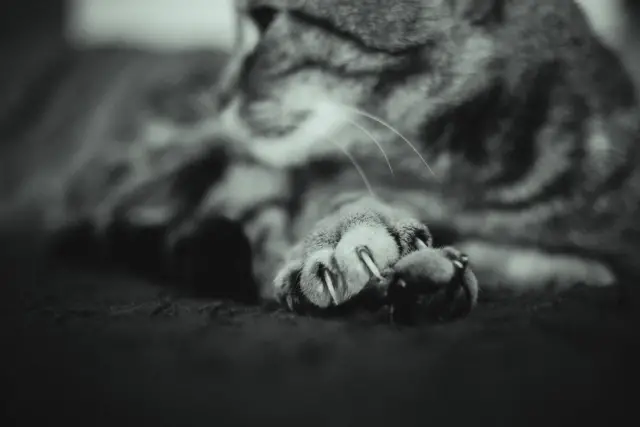
Nail-biting is a common behavior observed in cats that can often leave owners puzzled. This article aims to shed light on this curious habit and provide a deeper understanding of why cats engage in nail-biting. While most people associate nail-biting with humans, cats are also known to exhibit this behavior. Understanding the reasons behind nail-biting in cats is crucial for their well-being and can help in preventing or managing this habit effectively.
Cats use their nails for various purposes, such as hunting, climbing, and self-defense. However, when a cat starts biting its nails excessively, it may be a sign of an underlying issue. Nail-biting in cats can be caused by medical conditions, behavioral issues, or stress triggers. By identifying the root cause, owners can take appropriate measures to address the problem and ensure their feline friend’s overall health and happiness.
The reasons behind nail-biting in cats
There are several reasons why cats bite their nails. One common cause is overgrown nails. Cats’ nails continuously grow, and if they are not worn down naturally through scratching or outdoor activities, they can become too long, causing discomfort or even pain. In an attempt to alleviate this discomfort, cats may resort to biting their nails.
Another reason cats engage in nail-biting is due to behavioral issues. Cats are known to be meticulous groomers, and excessive nail-biting can be a result of compulsive grooming behavior. This behavior can be triggered by stress, anxiety, or boredom. Cats may find comfort in nail-biting as a form of self-soothing or as a way to redirect their energy.
Stress triggers such as changes in the environment, household dynamics, or the presence of other animals can also lead to nail-biting in cats. Cats are sensitive creatures, and they may resort to nail-biting as a coping mechanism when faced with stressful situations. Identifying and addressing these triggers can help alleviate the behavior and provide a stress-free environment for the cat.
Medical conditions that may cause nail-biting in cats
Nail-biting in cats can also be a symptom of underlying medical conditions. Skin allergies, infections, or parasites can cause itchiness and discomfort, leading to excessive grooming and nail-biting. It is essential to rule out any medical issues by consulting a veterinarian. A thorough examination, including skin tests and blood work, can help identify any underlying health problems that may be contributing to the nail-biting behavior.
Dental problems can also lead to nail-biting in cats. Cats with oral pain or discomfort may resort to biting their nails as a way to distract themselves from the discomfort in their mouths. Regular dental check-ups and proper oral care can help prevent dental issues and subsequently reduce nail-biting behaviors associated with them.
Behavioral issues and stress as triggers for nail-biting in cats
Behavioral issues and stress are significant triggers for nail-biting in cats. Cats are creatures of habit and thrive in a stable and stress-free environment. Changes in routine, introduction of new pets, or even loud noises can cause stress and anxiety in cats, leading to nail-biting as a response.
To prevent and manage nail-biting in cats, it is crucial to provide a stress-free environment. This can be achieved by maintaining a consistent daily routine, providing ample mental and physical stimulation through play and interaction, and creating safe spaces where cats can retreat and feel secure. Additionally, the use of pheromone sprays or diffusers can help create a calming atmosphere for the cat.
How to prevent and manage nail-biting in cats
Preventing and managing nail-biting in cats requires a multi-faceted approach. Firstly, regular nail maintenance is essential. Trimming your cat’s nails regularly can prevent them from becoming too long and uncomfortable, reducing the need for nail-biting. It is important to use proper nail clippers designed specifically for cats and to exercise caution while trimming to avoid injury.
In addition to regular nail trims, providing appropriate scratching surfaces is crucial for a cat’s nail health. Cats naturally have the instinct to scratch, and by providing scratching posts or boards, you can redirect their nail-biting behavior to a more appropriate outlet. Experimenting with different materials and textures can help you identify your cat’s preferences and encourage them to use the scratching surfaces.
Tips for providing a stress-free environment for cats
Creating a stress-free environment for cats can significantly reduce nail-biting behaviors. Here are some tips to help provide a stress-free environment for your feline friend:
- Maintain a consistent routine: Cats thrive on routine and predictability. Stick to a regular schedule for feeding, playtime, and sleep to provide a sense of stability for your cat.
- Provide mental and physical stimulation: Engage your cat in interactive play sessions and provide toys that encourage exercise and mental stimulation. This helps alleviate boredom and redirects their energy away from nail-biting.
- Create safe spaces: Cats need their own space where they can retreat and relax. Provide cozy hiding spots or cat trees where your cat can feel secure and safe.
- Use pheromone products: Pheromone sprays or diffusers can create a calming atmosphere for cats. These products mimic natural feline pheromones, helping to reduce stress and anxiety.
When to seek veterinary help for nail-biting in cats
While occasional nail-biting in cats may not be a cause for concern, persistent and excessive nail-biting should prompt a visit to the veterinarian. A veterinarian can help identify any underlying medical conditions or behavioral issues contributing to the nail-biting behavior. They can provide appropriate treatment or behavioral modification strategies to address the problem effectively.
If your cat’s nail-biting behavior is accompanied by other concerning symptoms such as hair loss, skin lesions, or changes in appetite or behavior, it is essential to seek veterinary help promptly. These symptoms may indicate a more serious underlying issue that requires immediate attention.
Understanding the role of grooming in cats’ nail health
Grooming plays a vital role in a cat’s overall well-being, including their nail health. Regular grooming helps cats maintain a clean and healthy coat, as well as ensuring their nails are in good condition. Cats use their tongues and teeth to groom themselves, and this includes biting their nails. However, when nail-biting becomes excessive or compulsive, it can lead to various problems.
Excessive nail-biting can cause trauma to the nails and surrounding tissues, leading to inflammation or infection. It can also result in the nails becoming weak or brittle, making them more prone to breakage. Understanding the balance between normal grooming behavior and excessive nail-biting is crucial for maintaining a cat’s overall nail health.
Nail care for cats – trimming and alternatives to scratching
Regular nail care is essential for cats, especially those who do not have opportunities to wear down their nails naturally. Trimming your cat’s nails every few weeks can prevent them from becoming too long and uncomfortable. It is important to use proper nail clippers designed for cats and to be gentle and patient during the process.
If your cat is resistant to having their nails trimmed, there are alternative methods to consider. Soft nail caps, such as those made of silicone, can be applied to the cat’s nails to prevent scratching and nail-biting. These caps are safe and temporary, and they fall off naturally as the cat’s nails grow. However, it is essential to consult with a veterinarian or professional groomer before using nail caps to ensure proper application and fit.
Final thoughts on nail-biting in cats
Nail-biting in cats is a behavior that can have various underlying causes, including medical conditions, behavioral issues, or stress triggers. Understanding the reasons behind nail-biting and taking appropriate measures can help prevent or manage this behavior effectively. Regular nail maintenance, providing appropriate scratching surfaces, and creating a stress-free environment are crucial steps in ensuring a cat’s overall well-being and nail health.
By being attentive to your cat’s behavior, seeking veterinary help when needed, and providing the necessary care and attention, you can help your feline friend lead a happy and nail-biting-free life.
If you enjoyed my article, I would appreciate you sharing it with your network.

Sima Ndlebe
Sima writes for CatBuzz. He is interested in Cats, Health and Fitness, and Entrepreneurship.
Published: 2 May 2024



